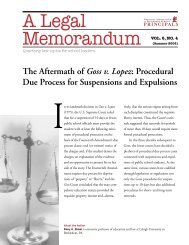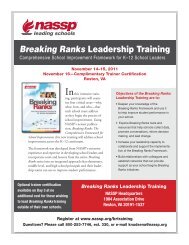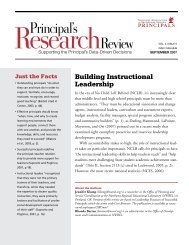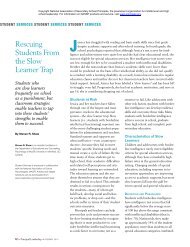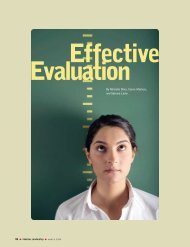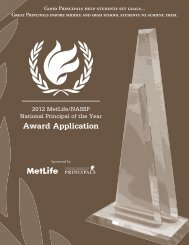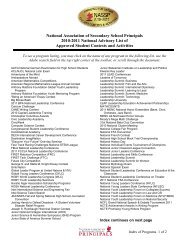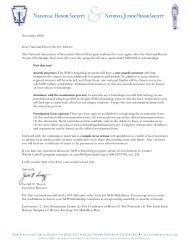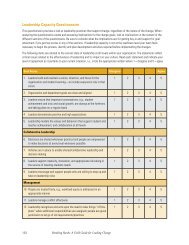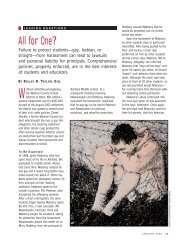developing the 21st century principal - National Association of ...
developing the 21st century principal - National Association of ...
developing the 21st century principal - National Association of ...
Create successful ePaper yourself
Turn your PDF publications into a flip-book with our unique Google optimized e-Paper software.
DEVELOPINGTHE 21 STCENTURYPRINCIPALFREQUENTLY ASKED QUESTIONS© 2004<strong>National</strong> <strong>Association</strong><strong>of</strong> Secondary School Principals1904 <strong>Association</strong> DriveReston, Virginia 20191-1537
NASSP ASSESSMENT CENTERSA Diagnostic – Prescriptive Approach to Pr<strong>of</strong>essional DevelopmentWHAT IS AN ASSESSMENT CENTER?An assessment center is a diagnostic tool for determining <strong>the</strong> presence and strength <strong>of</strong> leadershipskills <strong>of</strong> current and prospective school <strong>principal</strong>s. An assessment center is a process, not a location.Participants engage in an integrated system <strong>of</strong> realistic, school-based simulations designed togenerate behaviors similar to those required for success in K-12 <strong>principal</strong> positions.The assessment center generates data regarding strengths and improvement needs that can be used to:• Help identify prospective <strong>principal</strong>s and provide focused developmental activities for <strong>the</strong>m.(We must go beyond small pool <strong>of</strong> current assistant <strong>principal</strong>s for our future leaders.)• Provide focused pr<strong>of</strong>essional development for new <strong>principal</strong> induction• Help experienced <strong>principal</strong>s plan <strong>the</strong>ir own pr<strong>of</strong>essional growth strategies.WHY ARE ASSESSMENT CENTERS VALUABLE?NASSP’s 25-year history <strong>of</strong> work with assessment centers has been a factor in streng<strong>the</strong>ning<strong>principal</strong> preparation programs across <strong>the</strong> country. NASSP’s work substantially influenced <strong>the</strong>collaborative development <strong>of</strong> <strong>the</strong> <strong>National</strong> Policy Board for Educational Administration (NPBEA) 21Domains, and <strong>the</strong> subsequent development <strong>of</strong> <strong>the</strong> Interstate School Leaders Licensure Consortium(ISLLC) Standards. One <strong>of</strong> <strong>the</strong> major results <strong>of</strong> <strong>the</strong>se efforts is that <strong>principal</strong> preparation programsare combining <strong>the</strong> knowledge base with <strong>the</strong> skills essential to performance to create more effectivepreparation programs.Specifically, NASSP’s Assessment Center programs:• Provide diagnosis prior to “treatment” for more effective, highly targeted pr<strong>of</strong>essionaldevelopment• Base pr<strong>of</strong>essional development on data about strengths and improvement needs.• Help districts develop potential <strong>principal</strong>s to fill future vacancies with qualifiedindividuals• Address <strong>the</strong> shortage <strong>of</strong> qualified <strong>principal</strong>s by determining <strong>the</strong> leadership potential <strong>of</strong>prospective and aspiring leaders and tailoring developmental programs on <strong>the</strong> basis <strong>of</strong>data about <strong>the</strong>ir skills and developmentWHAT ARE ADDITIONAL BENEFITS OF AN ASSESSMENT CENTER?NASSP’s Assessment Centers:• Objectively identify assessees’ strengths and developmental needs and indicate pertinenttraining needs• Offer developmentally based succession planning• Provide a strong feedback component and a structure for individual development• Provide a focus for continued mentoring and coaching• Guide program design in <strong>developing</strong> effective programs for aspiring as well as practicing<strong>principal</strong>sWHO CONDUCTS NASSP ASSESSMENT CENTERS?NASSP works with individual school districts, consortia <strong>of</strong> school districts, regional service agencies,state departments <strong>of</strong> education, boards <strong>of</strong> cooperative services, universities, associations, o<strong>the</strong>rproviders <strong>of</strong> programs and services to establish locally operated assessment centers. NASSPprovides local/regional assessors with <strong>the</strong> knowledge and skills to conduct assessment centers.Centers are conducted as local demand dictates. NASSP does not conduct assessment centers; ra<strong>the</strong>r,NASSP provides initial and on-going training and assistance to assessment center directors andassessors.
WHO ARE THE ASSESSORS?Assessors are selected from a pool <strong>of</strong> talented individuals who have school leadership experience andtraining in <strong>the</strong> assessment process. The assessors have a broad familiarity with <strong>the</strong> <strong>principal</strong>ship andhave demonstrated outstanding performance and success in school leadership positions. Generally,assessors have supervised <strong>principal</strong>s or have held or currently hold that position. Assessors must bevery familiar with <strong>the</strong> <strong>principal</strong>ship. They also need excellent group-interaction skills, must be keenobservers <strong>of</strong> behavior, and be able to record behavior accurately. They need to write well. Theyneed to possess stamina and energy, and <strong>the</strong>y certainly need patience.During <strong>the</strong> three-day assessor training, candidates experience <strong>the</strong> entire assessment center process.They study all <strong>the</strong> materials used in <strong>the</strong> center. They learn to ga<strong>the</strong>r data and practice data collectionduring demonstration activities. They learn to perform <strong>the</strong> various roles that are assigned to assessorsduring <strong>the</strong> center, and <strong>the</strong>y learn to report behavior in terms <strong>of</strong> specific skills. The focus <strong>of</strong> assessortraining is careful observation, accurate behavior recording, analysis <strong>of</strong> observed behavior, andconcise reporting <strong>of</strong> demonstrated skills.WHAT ASSESSMENT MODELS ARE AVAILABLE FROM NASSP?The <strong>National</strong> <strong>Association</strong> <strong>of</strong> Secondary School Principals currently <strong>of</strong>fers five assessment centermodels: Developing <strong>the</strong> <strong>21st</strong> Century Principal (S&D); Developing <strong>the</strong> 21 st Century Principal;Advanced Leaders Developmental Assessment Center; Developmental Assessment Center (DAC);and Superintendents Leadership Development Program (SLDP).DEVELOPING THE 21 ST CENTURY PRINCIPAL:NASSP’s Developing <strong>the</strong> <strong>21st</strong> Century Principal Assessment Center is a process for measuringparticipants’ potential success in K–12 school leadership positions. The assessment center is aneffective method for providing a “diagnosis” prior to “treatment,” resulting in more effective andhighly targeted pr<strong>of</strong>essional development for school leaders. In addition, <strong>the</strong> assessment centerimproves <strong>the</strong> soundness <strong>of</strong> placement and selection decisions by diagnosing participants’ behavioralstrengths and improvement needs. The assessment center is a valuable tool for identifying leadershippotential, diagnosing strengths and weaknesses, and assisting in planning appropriate pr<strong>of</strong>essionaldevelopment strategies.RESEARCH BASE FOR Developing <strong>the</strong> 21 st Century Principal ASSESSMENT CENTER:NASSP’s Developing <strong>the</strong> <strong>21st</strong> Century Principal Assessment Center is based on a set <strong>of</strong> skilldimensions derived from <strong>the</strong> practice <strong>of</strong> successful <strong>principal</strong>s by means <strong>of</strong> an extensive job analysis.These skill dimensions reflect <strong>the</strong> challenges <strong>of</strong> today’s <strong>principal</strong>ship.The skills that form NASSP’s Developing <strong>the</strong> <strong>21st</strong> Century Principal Assessment Center reflect <strong>the</strong>original NASSP 12 skill dimensions, <strong>the</strong> 21 domains developed by <strong>the</strong> <strong>National</strong> Pr<strong>of</strong>essional Boardfor Educational Administration (NPBEA), <strong>the</strong> Interstate School Leaders Licensure Consortium(ISLLC) Standards for School Leaders, and <strong>the</strong> guidelines for school administration developed by<strong>the</strong> <strong>National</strong> Council for <strong>the</strong> Accreditation <strong>of</strong> Teacher Education (NCATE).In addition, NASSP called upon <strong>the</strong> knowledge and experience <strong>of</strong> successful practitioners in everyregion <strong>of</strong> <strong>the</strong> country (secondary school <strong>principal</strong>s, assessment and development center directors,pr<strong>of</strong>essors <strong>of</strong> secondary school administration, and psychologists) in establishing this set <strong>of</strong> skilldimensions.
NASSP’S Developing <strong>the</strong> <strong>21st</strong> Century Principal ASSESSMENT CENTER SKILL DIMENSIONSARE:Educational Leadership Setting Instructional DirectionImplementing strategies for improving teaching and learning including putting programsand improvement efforts into action. Developing a vision and establishing clear goals;providing direction in achieving stated goals; encouraging o<strong>the</strong>rs to contribute to goalachievement; securing commitment to a course <strong>of</strong> action from individuals and groups. TeamworkSeeking and encouraging involvement <strong>of</strong> team members. Modeling and encouraging <strong>the</strong>behaviors that move <strong>the</strong> group to task completion. Supporting group accomplishment. SensitivityPerceiving <strong>the</strong> needs and concerns <strong>of</strong> o<strong>the</strong>rs; dealing tactfully with o<strong>the</strong>rs in emotionallystressful situations or in conflict. Knowing what information to communicate and towhom. Relating to people <strong>of</strong> varying ethnic, cultural, and religious backgrounds. Development <strong>of</strong> O<strong>the</strong>rsTeaching, coaching, and helping o<strong>the</strong>rs. Providing specific feedback based onobservations and data.Resolving Complex Problems JudgmentReaching logical conclusions and making high quality decisions based on availableinformation. Giving priority and caution to significant issues. Seeking out relevantdata, facts, and impressions. Analyzing and interpreting complex information. Results OrientationAssuming responsibility. Recognizing when a decision is required. Taking promptaction as issues emerge. Resolving short-term issues while balancing <strong>the</strong>m against longtermobjectives. Organizational AbilityPlanning and scheduling one’s own and <strong>the</strong> work <strong>of</strong> o<strong>the</strong>rs so that resources are usedappropriately. Scheduling flow <strong>of</strong> activities; establishing procedures to monitorprojects. Practicing time and task management; knowing what to delegate and to whom.Communication Oral CommunicationClearly communicating. Making oral presentations that are clear and easy tounderstand. Written CommunicationExpressing ideas clearly in writing; demonstrating technical pr<strong>of</strong>iciency. Writingappropriately for different audiences.
Developing <strong>the</strong> 21 st Century Principal Assessment Center Design:The half-day assessment center consists <strong>of</strong> challenging simulations that provide a realistic job preview <strong>of</strong><strong>the</strong> <strong>principal</strong>ship. The assessment center experience consists <strong>of</strong> three to five inter-related simulations.Participants engage in an in-basket exercise that provides context for each <strong>of</strong> <strong>the</strong> subsequent exercises.Participants confer with a teacher to discuss instructional issues, meet with a parent to resolve parentalcomplaints, and have <strong>the</strong> option to participate in a group meeting to discuss new design features for adistrict-wide teacher performance appraisal system. They may also be given <strong>the</strong> opportunity to provide aformal oral presentation or writing sample. In addition, participants supply biographical information thatis used in suggesting appropriate developmental strategies.INFORMATION PARTICIPANTS RECEIVE FROM THE Developing <strong>the</strong> 21 st Century PrincipalASSESSMENT CENTER:Each assessment center participant receives a report describing his or her strengths and improvementneeds in each <strong>of</strong> <strong>the</strong> nine skill dimensions, as well as detailed suggestions for improvement and growth.The assessment center report is delivered in a face-to-face feedback sessions with <strong>the</strong> director <strong>of</strong> <strong>the</strong>center. This valuable feedback session allows <strong>the</strong> director to provide and interpret <strong>the</strong> results and help <strong>the</strong>participant think about his or her own career progress and future pr<strong>of</strong>essional development.THE VALUE OF AN ASSESSMENT REPORT:The assessment report provides <strong>the</strong> assessment center participant with <strong>the</strong> basis for fur<strong>the</strong>r reflection on<strong>the</strong>ir strengths and improvement needs. This reflection assists <strong>the</strong>m in planning specific pr<strong>of</strong>essionalgrowth strategies. The participant should feel comfortable sharing an assessment report with anyone whomight provide suggestions, assignments, or opportunities to practice and develop skills; who might givefeedback on progress as practice and development occur; and who might provide support andencouragement. For example, a <strong>principal</strong> might share an assessment report with a mentor. An assistant<strong>principal</strong> might share <strong>the</strong> assessment report with <strong>the</strong> <strong>principal</strong>.The organization as a whole benefits from assessment reports by receiving objective data about <strong>the</strong>training and developmental needs <strong>of</strong> <strong>the</strong> participants. Assessment reports also provide individual andgroup skill diagnosis that help an organization move from a “one size fits all” approach to personneldevelopment to a highly prescriptive approach to individual and group pr<strong>of</strong>essional development.HOW PARTICIPATION IN AN ASSESSMENT CENTER BENEFITS EXPERIENCED PRINCIPALS:All <strong>principal</strong>s may be served by developmental assessment regardless <strong>of</strong> <strong>the</strong>ir experience. Developmentalassessment provides an essential ingredient for growth. In too many cases, <strong>the</strong> experienced <strong>principal</strong>receives little meaningful feedback about performance on <strong>the</strong> job. The feedback provided indevelopmental assessment is specific and is focused on skills essential to effective school leadership.Developmental assessment provides collegial interaction as <strong>the</strong> individual develops pr<strong>of</strong>essional growthplans, and it leads <strong>the</strong> participant to reexamine best practices.TIME REQUIRED FOR PARTICIPATION IN NASSP’s Developing <strong>the</strong> 21 st Century PrincipalASSESSMENT CENTER:The Developing <strong>the</strong> 21 st Century Principal Assessment Center is a half-day experience for participantsthat includes multiple, inter-related activities. The activities are strongly correlated to tasks <strong>principal</strong>sperform daily. Examples <strong>of</strong> activities include an in-basket and a meeting with a teacher and a parent.Optional activities <strong>of</strong>fered at <strong>the</strong> discretion <strong>of</strong> <strong>the</strong> local center are a group activity, a formal oralpresentation, and/or a formal writing sample. For assessors, <strong>the</strong> assessment center is a two to two-and-ahalfday commitment.
VALIDITY OF Developing <strong>the</strong> <strong>21st</strong> Century Principal ASSESSMENT CENTER:The Guidelines and Ethical Considerations for Assessment Center Operations endorsed by <strong>the</strong> 28thInternational Congress on <strong>the</strong> Assessment Center Method (2000) states, “A major factor in <strong>the</strong>widespread acceptance and use <strong>of</strong> assessment centers is related directly to an emphasis on soundvalidation research. Ascertaining <strong>the</strong> validity <strong>of</strong> an assessment center program is a complicated technicalprocess, and it is important that validation research meet both pr<strong>of</strong>essional and legal standards. Validitygeneralization studies <strong>of</strong> assessment center research suggests that overall assessment ratings derived in amanner conforming to <strong>the</strong>se guidelines show considerable predicative validity.”To ensure a content-valid process, NASSP’s Office <strong>of</strong> Leadership Development and Assessment included<strong>the</strong> following steps in building Developing <strong>the</strong> <strong>21st</strong> Century Principal Assessment Center.• NASSP hired Applied Research, Inc., headed by Dr. Joel Moses, a respected leader in <strong>the</strong> field <strong>of</strong>executive selection and development, to develop <strong>the</strong> process. Dr. Moses, leader <strong>of</strong> <strong>the</strong> assessmentcenter movement, has published many books and articles on this topic, including <strong>the</strong> definitivebook on executive assessment, Applying <strong>the</strong> Assessment Center Method.• Applied Research conducted a job analysis <strong>of</strong> <strong>the</strong> <strong>principal</strong>ship. This job analysis consisted <strong>of</strong>interviewing <strong>principal</strong>s, assistant <strong>principal</strong>s, superintendents, community leaders, school boardmembers, parents, and college pr<strong>of</strong>essors to identify <strong>the</strong> critical elements <strong>of</strong> <strong>the</strong> <strong>principal</strong>ship. Inaddition, Applied Research consulted <strong>the</strong> two major validity studies conducted on <strong>the</strong> originalNASSP Assessment Center. These studies, conducted by Dr. Neal Schmidt at Michigan StateUniversity, provided insight in <strong>the</strong> selection <strong>of</strong> <strong>the</strong> skill dimensions to be chosen for <strong>the</strong> newprocess.• Applied Research combined <strong>the</strong> job analysis with <strong>the</strong> review <strong>of</strong> data from <strong>the</strong> 21 Domainsdeveloped by <strong>the</strong> <strong>National</strong> Pr<strong>of</strong>essional Board for Educational Administration (NPBEA), TheInterstate School Leaders Licensure Consortium (ISLLC) Standards for School Leaders, and <strong>the</strong>guidelines for school administration developed by <strong>the</strong> <strong>National</strong> Council for <strong>the</strong> Accreditation <strong>of</strong>Teacher Education (NCATE) and developed a preliminary list <strong>of</strong> skill dimensions to be includedin Developing <strong>the</strong> 21 st Century Principal Assessment Center. These proposed skills weresubjected to wide review and scrutiny by experts in assessment as well as those knowledgeableabout <strong>the</strong> <strong>principal</strong>ship. This proposed list <strong>of</strong> skill dimensions were sent for review and commentsto assessment center directors in 50 centers located in 23 states, NASSP’s state executive directors,members <strong>of</strong> NASSP’s Pr<strong>of</strong>essors <strong>of</strong> Secondary School Administration Committee, and o<strong>the</strong>rinterested parties. The responses from <strong>the</strong>se groups and individuals were used to make <strong>the</strong> finaldetermination <strong>of</strong> <strong>the</strong> skill lists. From <strong>the</strong> skill dimensions, <strong>the</strong> assessment exercises weredeveloped and piloted.• The scoring process utilized in <strong>the</strong> assessment procedure was developed through more than 20years <strong>of</strong> work in assessment. Proven scoring rubrics have been tested and shown successfulthrough <strong>the</strong> assessment <strong>of</strong> more than 15,000 participants in <strong>the</strong> original NASSP AssessmentCenter. The two validity studies – 1979 and 1991 – have indicated that <strong>the</strong> NASSP AssessmentCenter is valid. The 1991 study stated, “In conclusion, we see <strong>the</strong> assessment center as a contentvalid procedure for <strong>the</strong> selection <strong>of</strong> school administrators.”HOW Developing <strong>the</strong> 21 st Century Principal ASSESSMENT CENTER DIFFERS FROM THEORIGINAL NASSP Principal Assessment Center:Developing <strong>the</strong> <strong>21st</strong> Century Principal is a newly developed process, not a revision <strong>of</strong> <strong>the</strong> old assessmentcenter program. While Developing <strong>the</strong> 21 st Century Principal Assessment Center builds on <strong>the</strong> successes<strong>of</strong> <strong>the</strong> original assessment center, it has significant differences, including a focus on <strong>the</strong> nine skilldimensions that accurately reflect <strong>the</strong> role <strong>of</strong> today’s <strong>principal</strong> as an instructional leader ra<strong>the</strong>r than just amanager, and a major reduction in <strong>the</strong> time commitment for assessment center participants and forassessors.



